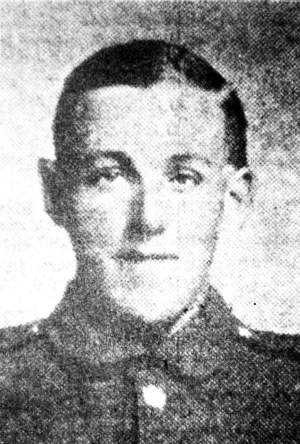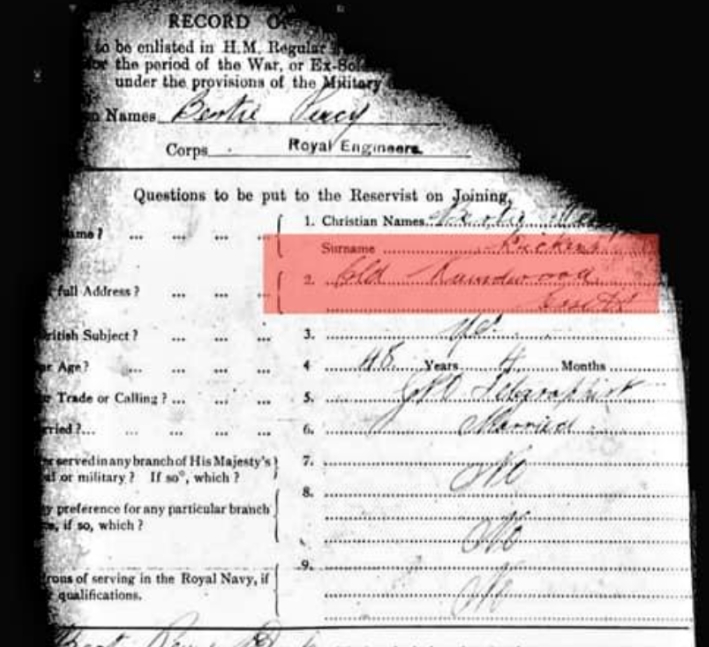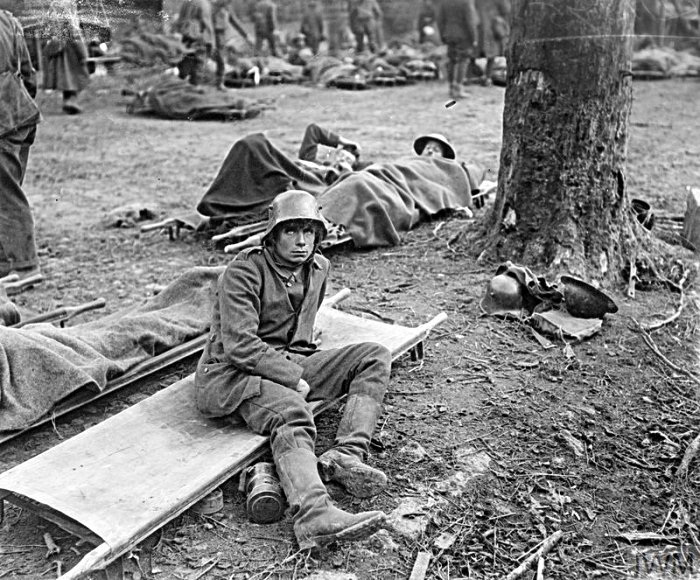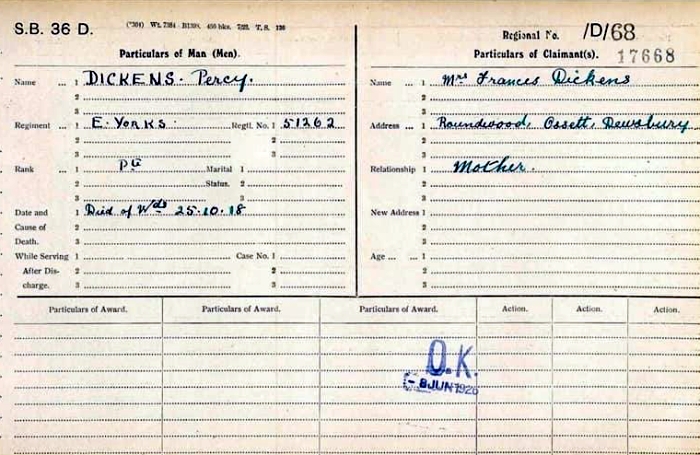 Private Percy Dickens, 51262, 7th Battalion, East Yorkshire Regiment
Private Percy Dickens, 51262, 7th Battalion, East Yorkshire Regiment
Percy Dickens and his twin sister Constance were born in Burton-on-Trent on July 14th 1896. Their parents, Frances (Fanny) Vials and Bertie Percy Dickens, had married there on January 16th 1894. By 1897, when their next child Harold was born, the family had moved to Leeds. The births of their next three children, Ethel, Elsie and Charlie, were registered in Leeds yet information supplied by their father and recorded on Percy's WW1 Service Record states that they were all born in Ossett between 1902 and 1905.
In 1918, during the last months of WW1, the Military Service Act raised the age limit for those eligible for service to 51 years. Bertie Dickens was 48 years-old when he enlisted in September that year in the Royal Engineers with service number 600713. Just two months before the signing of the Armistice; the beginning of the end of WW1. Prior to this Act only men aged between 18 and 41 years could become soldiers. Before the war Bertie worked for the General Post Office (GPO) as a telephone inspector and fitter.
Bertie did return to his family and his home at Roundwood after the end of WW1. His eldest son 22 year old Percy, a miner at Roundwood Colliery, sadly did not.
Percy lived with his family at Eastwood's Buildings at Roundwood. Some of Roundwood is in Alverthorpe, but part of Alverthorpe was included in the Ossett Borough by the Local Government Board's Provisional Orders Act 1900. The UK, WWI Pension Ledgers and Index Cards, 1914-1923 clearly states that Percy's address was 'Old Roundwood, Ossett'.
It is not known when Percy Dickens joined the army, but he enlisted first as Private 52817, in the 5th Battalion, King's Own Yorkshire Light Infantry, before being transferred to the East Yorkshire Regiment.

Above: Bertie Percy Dickens' 1918 army enlistment record in the Royal Engineers that clearly shows his address is Roundwood, Ossett.
7th (Service) Battalion of the East Yorkshire Regiment was formed on the 16th September 1914 at Beverley as part of the Second New Army (K2) in the 50th Brigade of the 17th (Northern) Division. They then moved to Wareham in May 1915 and then to Romsey. On the 14th July 1915, the battalion was mobilised for war and landed at Boulogne. They engaged in various actions on the Western Front including during 1916, the Battle of Albert and the Battle of Delville Wood.
During 1917 they fought in the First and Second Battles of the Scarpe; the Capture of Roeux; the First and Second Battles of Passchendaele.
During 1918 they saw action in the Battle of St Quentin; the Battles of Bapaume; the Battle of Amiens; the Battle of Albert; the Battle of Havrincourt; the Battle of Epehy; the Battle of Cambrai, the pursuit to the Selle; the Battle of the Selle and the Battle of the Sambre, ending their war in Aulnoye, France.
The 7th Battalion, East Yorkshire Regiment formed part of the 17th [Northern] Division, along with the 10th West Yorks, 7th Yorkshire Regiment [Green Howards], and the 6th Dorsets.
It was during the Battle of the Selle that Private Percy Dickens was wounded on the 20th October 1918 and taken to one of the military hospitals at Le Treport where he died. Le Treport was an important hospital centre and by July 1916, the town contained three general hospitals (the 3rd, 16th and 2nd Canadian), No.3 Convalescent Depot and Lady Murray's B.R.C.S. Hospital. The 7th Canadian, 47th and 16th USA General Hospitals arrived later.

Above: German and British wounded at the Battle of the Selle in October 1918.
From the War Diary of the 7th Battalion, East Yorkshire Regiment:
"On the 20th October 1918, under a heavy and accurate barrage the East Yorkshires and Dorsets advanced at 2.00am, followed by the West Yorkshiremen. The enemy's reply was also equally severe, and at the very outset telephone wires between Battalion and Brigade Headquarters were cut by hostile shell-fire. With fine dash, and fighting splendidly, the two attacking battalions, in the face of fierce opposition and heavy fire from machine-guns and trench-mortars, interspersed at regular intervals of fifty yards along the railway, reached the first objective by 2.20 am according to timetable, and there paused for ten minutes under a protective barrage in order to reorganize for the advance on the second objective [south and west of Neuvilly]"
The Selle battle itself was a success for the British and small number of American troops engaged. Although they fought a much smaller German force they took 20,000 prisoners and made a significant advance. Historian J.P. Harris considers it one of the British Army's greatest victories.

Above: The record card showing the death of Private Percy Dickens and his address clearly marked as Roundwood, Ossett.
Private Percy Dickens 51262 7th East Yorkshire Regiment died of wounds on October 25th 1918. Sixteen days before the Armistice was signed. He is buried at Mont Huon Military Cemetery, Le Treport, on the French coast.
This is the personal inscription for his gravestone chosen by his father Bertie:
"ONLY THOSE WHO HAVE LOVED AND LOST CAN UNDERSTAND WAR'S BITTER COST"
In 1920, Private Percy Dickens' Service medals were delivered to his father at Eastwood's Buildings, Roundwood, Ossett.
The "Ossett Observer" for the 27th September 1941 carried a report about the death of Percy Dicken's father Bertie Percy Dickens while on active service during WW2 as a fire-watcher:
"OSSETT FIREWATCHER'S SUDDEN DEATH"
"COLLAPSED WHILST ON DUTY"
"At Ossett Town Hall on Thursday, Mr. C.J. Haworth (coroner) investigated the circumstances attending the death of Bertie Percy Dickens (70), 3 Eastwood Buildings, Wakefield Road, Ossett, who passed away suddenly on Monday night.
Charles Dickens, 4 Eastwood Buildings, screen foreman at Roundwood Colliery, said his father, who was a healthy man, had been a fire-watcher at the colliery for the past nine months. He went to his fire-watching duties as normal at 8:45 on Monday night and at about 9:20 he (witness) was fetched to the colliery by the engineer, and found his father lying against the engine house corner. He was alive, but did not speak. He was carried into the fire-watchers' hut, and Dr. Coad was sent for. On the doctor's advice he was conveyed to his home, which was nearby, and passed away at 11:30 that same night.
ENGINEMAN'S DISCOVERY
John Arthur Dickenson, 22, Hope Street, Ossett, winding engineman at Roundwood Colliery, said that about 8:50 p.m. on Monday, he saw Dickens coming to his work as a fire-watcher, and noticed him stopping to examine the office windows with his lamp before clocking in. He asked if Dickens was keeping well, and he replied "middling", but the impression given to him by his tone of voice was that he was not quite normal. Witness went across to the other engine room, and when returning, about 15 minutes later, he found Dickens lying on the ground, apparently in a state of collapse. Being unable to rouse him, he sent for Dickens's son, and the old man was moved into the hut.
Dr. Coad said he arrived at the hut shortly before 10 p.m., and after examining the man, decided that he should be removed home. He was unconscious and his breathing was heavy and stertorous. He had since made a post-mortem examination and found cerebral haemorrhage. There were slight abrasions on the temple, and each shin, but these had nothing to do with the cause of death, which was purely natural. The other organs of the body were very healthy.
CAUSE OF DEATH
A member of the family raised a point as to the face abrasion, and Dickenson recalled, stated in reply to the coroner that Dickens would no doubt scrape the wall as he fell on to the ground. In answer to the coroner, Dr. Coad said he was quite of the opinion that the fall was due to the haemorrhage and not the haemorrhage to the fall. It was probable that the tone of speech of speech referred to by Dickenson was premonitory to the seizure. A verdict that he died from a cerebral haemorrhage or natural causes was recorded.
Mr. Dickens, who had lived at Roundwood for 35 years, was very well known and much respected. A native of Burton-on-Trent, he came to this district as a telephone fitter in the Wakefield area of the General Post Office, retiring about ten years ago. For the past nine months he had been employed as a fire-watcher at Roundwood Colliery. He leaves a widow, two sons and three daughters, with whom much sympathy is felt. The funeral took place at Alverthorpe Church yesterday".
Thanks to Anne-Marie Fawcett for her detailed research on Private Percy Dickens.
References:
1. Ossett Through The Ages Facebook Group.